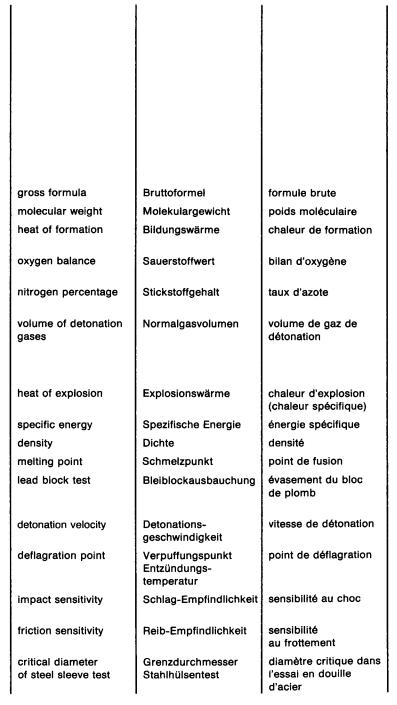
Meyer R., Koehler J., Homburg A. Explosives. Wiley-VCH, 2002 / Explosives 5th ed by Koehler, Meyer, and Homburg (2002)
.pdf
, Fifth Edition Rudolf Meyer, Josef Köhler, Axel Homburg
R. Meyer
J. Köhler
A. Homburg
Explosives

, Fifth Edition Rudolf Meyer, Josef Köhler, Axel Homburg
Rudolf Meyer
Josef Köhler
Axel Homburg
Explosives
Fifth, Completely
Revised Edition

, Fifth Edition Rudolf Meyer, Josef Köhler, Axel Homburg
Dr. Rudolf Meyer (†)
(formerly: WASAG Chemie AG, Essen, Germany)
Josef Köhler
Grub 42
A-4784 Schardenberg
Dr.-Ing. Axel Homburg c/o Dynamit Nobel AG Kaiserstr. 1
D-53839 Troisdorf
This book was carefully produced. Nevertheless, authors and publisher do not warrant the information contained therein to be free of errors. Readers are advised to keep in mind that statements, data, illustrations, procedural details or other items may inadvertently be inaccurate.
First Edition 1977
Second, Revised and Extended Edition 1981
Third, Revised and Extended Edition 1987
Fourth, Revised and Extended Edition 1994
Fifth, Completely Revised Edition, 2002
Library of Congress Card No.: Applied for.
British Library Cataloguing-in-Publication Data: A catalogue record for this book is available from the British Library.
Die Deutsche Bibliothek – CIP Cataloguing-in-Publication-Data
A catalogue record for this publication is available from Die Deutsche Bibliothek
© Wiley-VCH Verlag GmbH, Weinheim, 2002
ISBN 3-527-30267-0
Printed on acid-free paper.
All rights reserved (including those of translation in other languages). No part of this book may be reproduced in any form – by photoprinting, microfilm, or any other means – nor transmitted or translated into machine language without written permission from the publishers. Registered names, trademarks, etc. used in this book, even when not specifically marked as such, are not to be considered unprotected by law.
Composition: Typomedia, Ostfildern
Printing: Strauss Offsetdruck, Mörlenbach
Bookbinding: Wilh. Osswald + Co. KG, Neustadt
Cover Design: Wolfgang Scheffler, Mainz
Printed in the Federal Repubilc of Germany.

, Fifth Edition Rudolf Meyer, Josef Köhler, Axel Homburg
IN MEMORIAM
Rudolf Meyer
(1908 – 2000)
Dr. Rudolf Meyer was born on 4. 3. 1908 in Spandau (Berlin) and took his degree in Physical Chemistry. He began his initial studies in the area of energetic compounds in connection with his Doctor’s degree in 1931 at Professor Bodenstein’s Institute in Berlin with a paper on the enthalpy of formation and thermal decomposition of hydrazoic acid. After taking his Doctor’s degree, he entered the Dynamit Nobel Company in 1934 as assistant to Dr. Ph. Naoum. He worked there from 1936 –1945 on the development of pourable ammonium nitrate explosives and on hollow charges.
After the WWII he accepted a position as scientific adviser to the Government of Argentina in Buenos Aires. He returned to Germany in 1954 and was Technical Director of the WASAG Chemie AG Company, Essen until his retirement.
Dr. Rudolf Meyer died on 23. 5. 2000 in Essen. He is survived by his wife, to whom he was married for more than 60 years, and two grown-up sons.
Dr. Meyer devoted his entire professional life to the chemistry of explosives.
, Fifth Edition Rudolf Meyer, Josef Köhler, Axel Homburg
Preface
The continued positive response which the last edition of “Explosives” again received from our readers has encouraged the publishers and authors to retain the concept on which it has been based up to now.
Fortunately it was possible to obtain the services of Dr.-Ing. Axel Homburg to co-operate in this publication, and so this book now bears the names of three authors. Dr. Homburg was Chairman of the Management Board of the German Dynamit Nobel AG Company for many years and has been a member of the Supervisory Board since 1996.
Unfortunately, the original creator of this book, Dr. Rudolf Meyer, passed away during its preparation. Dr. Rudolf Meyer was also responsible for reviving and extensively revising “Explosivstoffe” in the German language, this work having initially been published by the WASAG-Chemie Company, Berlin, in a first edition in 1932. It has since become a standard work, already in its ninth edition.
In comparison with the fourth edition, and in addition to a few new and commercially attractive compounds of an explosive nature, particular importance has been given to the keyword “Airbag” because of its great topicality. At this point the authors would like to express special thanks to Dr. E. Gast (Contec GmbH) for providing the corresponding information. The authors would like to thank the Fraunhofer Institut für Chemische Technologie (ICT), Pfinztal/Berghausen, in particular Dr.- Ing. P. Elsner, Dr. S. Kelzenberg, Dr. Th. Keicher, Mr. Bathelt, Dr. N. Eisenreich, Dr. K. Menke and Dr. Volk for their advice and contributions to this book.
Because production figures in the explosives industry have been declining markedly for a number of years, the tabulation of product and trade names has been omitted for the time being.
As a new addition, a CD with a tabulation of the current enthalpies of formation and free energies of formation of the compounds occurring in this publication is included with the book for the first time. This tabulation is a compilation of data from the very comprehensive thermodynamic data base published and continually updated by the Fraunhofer Institute for Chemical Technology (ICT).
The authors would like to thank all our patrons and specialist colleagues who have helped to prepare this and previous editions of “Explosives”.
Among these may be mentioned Dr. D. Eckhart (BAM, Berlin), Dipl.- Ing. W. Franke (BAM, Berlin), Dipl.-Ing. H. Grosse † (WASAG Chemie), Dr. E. Häusler † (BICT), Dr. R. Hagel (DNAG, Fürth), Dr. H. Hornberg † (ICT), Dr. H. Krebs (BAM, Berlin), Dr. G. Kistner (ICT), Dr. J. Knobloch (WNC Nitrochemie), Prof. Dr H. Köhler † (Austron), Dr. A. Kratsch (Rheinmetall Industrie GmbH), Dip.-Ing. H. Krätschmer (DN
Preface |
VIII |
|
|
Wien GmbH), Dr. K. Meyer † (ICT), Prof. Dr.-Ing. K. Nixdorff (BW University, Hamburg), Dipl.-Ing. J. Prinz (Sprengtechnischer Dienst, Dortmund), Dr. K. Redecker (DNAG, Fürth), Dr. H. J. Rodner (BAM, Berlin), Dr. J. F. Roth † (DNAG, Troisdorf), Prof. Dr. H. Schubert (ICT), Prof. Dr. M. Steidinger (BAM, Berlin), Dipl.-Ing. G. Stockmann (WNCNitrochemie), Dr. G. Traxler (ORS Wien), Mr. R. Varosh (RISI, USA), Dr. F. E. Walker (Interplay, USA), Mr. J. Wraige (Solar Pyrotechnics, GB) and Dr. R. Zimmermann (BVS, Dortmund).
We hope that the large number of people who remain unmentioned will also feel that they share in this expression of thanks.
The authors also wish to thank the publishers, the WILEY-VCH Verlag GmbH Company, and in particular Mrs. K. Sora and Mr. P. Biel, for the most pleasant co-operation in the production and printing of this book.
The publishers and authors continue to welcome suggestions and communications of any kind. We hope that our book will remain an important reference work and a quick source of information in this edition as well.
Schardenberg, December 2001 |
Josef Köhler |
Axel Homburg |

From the preface of previous editions:
“Explosives” is a concise handbook covering the entire field of explosives. It was preceded by the booklet “Explosivstoffe” published in 1932 by WASAG, Berlin, and by the handbook of industrial and military explosives published by WASAG-CHEMIE in 1961 under the same name.
The book contains about 500 entries arranged in alphabetical order. These include formulas and descriptions of about 120 explosive chemicals, about 60 additives, fuels. and oxidizing agents, and a 1500-entry subject index.
The objective of the book is to provide fundamental information on the subject of explosives not only to experts but also to the general public. The book will therefore, apart from industrial companies and research facilities concerned, be found useful in documentary centers, translation bureaus, editorial offices, patent and lawyer offices, and other institutions of this nature.
The properties, manufacturing methods, and applications of each substance are briefly described. In the case of key explosives and raw materials, the standard purity specifications are also listed.
The asymmetric margins are provided for entries and marginal notes of the reader.
Instructions for the thermodynamic calculations of the performance parameters of high explosives, gun propellants, and rocket propellants are given in somewhat greater detail. The basic thermodynamic data will be found in the extensive synoptic tables. They are based on the metric system; conversion from the English or the U.S. system can be made using the conversion tables on the back flyleaf. The front flyleaf contains a glossary of the terms denoting the characteristics of explosive materials in six languages.
The standard temperature selected for the energy of formation and enthalpy of formation data is 25 °C = 299.25 K. The elementary form of carbon was taken to be graphite (and not diamond, as before). The numerical values of the energies of formation (which, as known, appear both in the relevant entry and in the tables) are the optimum molar values found in the enthalpy tables of Volk, Bathelt and Kuthe: “Thermochemische Daten von Raketentreibstoffen, Treibladungspulvern sowie deren Komponenten”, published by the Institut für Chemische Technologie (ICT), D-76327 Pfinztal-Berghausen 1972.
The US experts in rocket-techniques* and the Institute of Makers of Explosives** published glossaries on the definition and explanations of technical terms. Parts of them have been incorporated in the text.
* Published as appendix 4 of the Aerospace Ordnance Handbook by Pollard,
F. B. and Arnold, J. H. Prentice Hall Inc., 1966
**Published as Publication No. 12 by the Institute of Makers of Explosives.
From the preface of previous editions |
X |
|
|
The book is not intended as a systematic presentation of the science of explosives. Interested readers are referred to the many excellent publications on the subject, which are available in English (see, for example, the books by M. A. Cook) and the now nearly complete encyclopedia covering the whole explosive field, edited by Seymour M. Kaye (formerly by Basil T. Fedoroff †: “Encyclopedia of Explosives and Related Items”). Users of explosives should consult the “Blaster’s Handbook” of DU PONT Inc., which is by far the best book on the subject.
A comprehensive list of literature references will be found at the end of the book.

, Fifth Edition Rudolf Meyer, Josef Köhler, Axel Homburg

